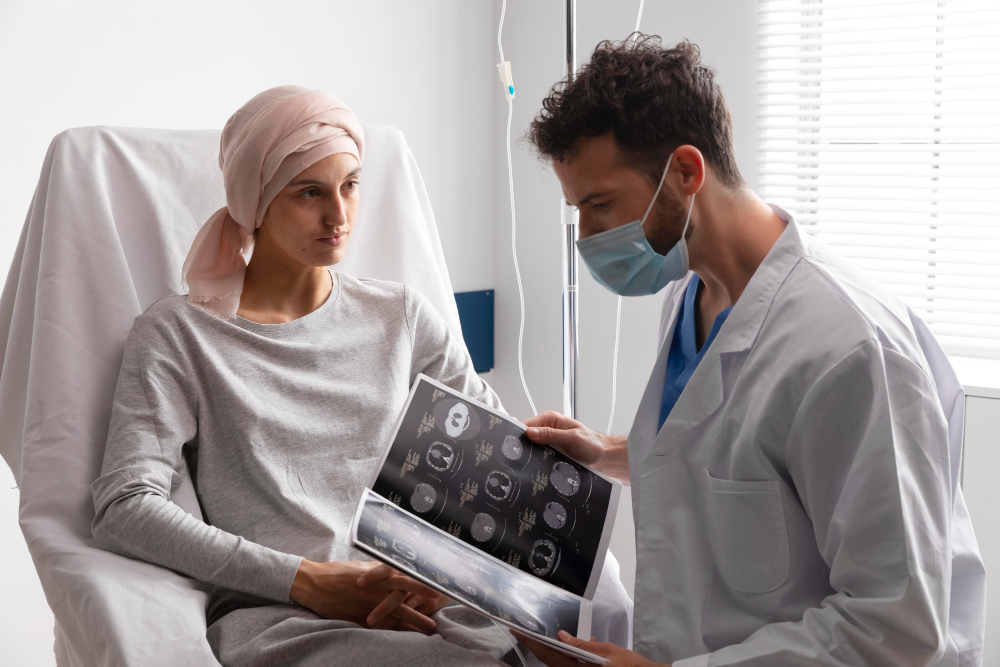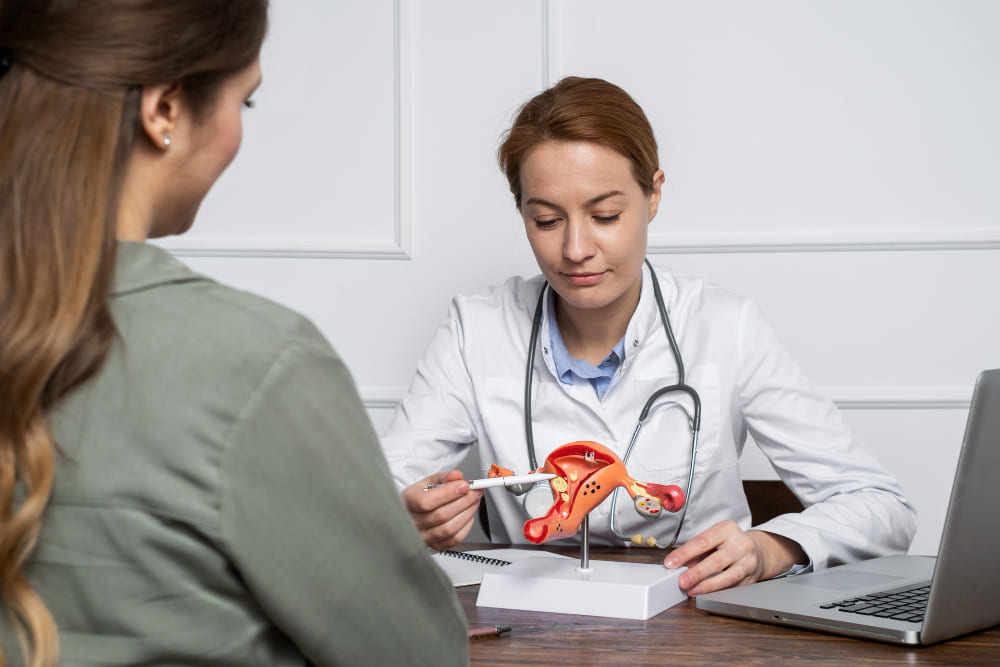Book on Whatsapp
9892101616
Understanding Tumor Markers and Their Role in Cancer Diagnosis
Cancer
Tue Mar 18 2025
Cancer is a disease that the world mainly fears, but lukewarm advances in cancer detection and treatment have been made in the medical field. Tumor markers are an integral component in the diagnosis of cancer. These are generally produced by cancer cells, and sometimes even by the patient as a lone product in their certain oncogenesis. They can be found in varying bodily fluids blood, urine, or tissue, and their examination helps one know if something malicious is present in his body.
What Are Tumor Markers
These are proteins, hormones, or other molecules secreted by a tumor or by the body in response to the tumor. On tumor markers, a laboratory test that can detect the presence of tumors and any other recurrences has been developed. They are not specific to cancer and may be elevated due to certain benign conditions as well.
How Are Tumor Markers Used
They also assist doctors in:
1. Screening and Early Detection
Some tumor markers are used for screening and early detection in cancer, although they are not by themselves reliable for making the diagnosis of cancer. Generally, tumor markers are combined with other diagnostic tests.
2. Diagnosis
The tumor markers may provide the confirmation of the diagnosis itself, while the other tests such as imaging and biopsies scans may be necessary.
3. Monitoring of Treatment
During a course of cancer treatment, the tumor marker can tell if treatment has been effective or not, depending on tumor marker levels.
4. Check for Recurrence
After treatment, doctors may watch tumor markers regularly to determine the return of cancer.
Common Tumor Markers and Their Associated Cancers
Tumor markers are proteins molded by cancer cells or by the body in response to cancer. Tumor markers help become aware of, diagnose, and monitor most cancers. PSA (Prostate Specific Antigen) assist in the recognition of prostate cancer. CA-125 is engaged to monitor ovarian cancer. CEA (Carcinoembryonic Antigen) is related with colon and rectal cancer and is present in diagnosis as well as for monitoring treatment. AFP (Alpha-fetoprotein) is associated to liver cancer and some testicular and ovarian malignancies. HER 2 (human epidermal growth factor receptor 2) is important in the case of breast cancer, in formation decisions regarding treatment. CA 19-9 is a useful indication for pancreatic cancer, enabling exposure and monitoring at an early stage. The tumor markers are highly useful, they are characteristically utilized in amalgamation with other tests to make more precise diagnosis.
Limitations of Tumor Markers
Tumor markers are quite useful, they are definitely not ideal. For instance, they may be elevated without the existence of cancer, in cases like infections or other medical conditions. Inversely, an individual may have cancer and unable to show elevated levels altogether. Because of this, the doctors do not rely on tumor markers alone to detect a particular disease but instead incorporate other means, such as imaging studies, biopsies, and laboratory tests.
How Do Doctors Perform Tumor Marker Tests
The tumor markers can be useful but are not completely reliable at times. Elevation of the tumor markers may happen sometimes without a cause of cancer, like in some infections or other medical situations. Likewise, an individual may have cancer and not present elevated tumor marker levels every single time. Because of this reason, the doctor comparatively never uses tumor markers in isolation to determine treatment plans, rather uses it in conjunction with imaging scans, biopsies, and additional independent laboratory tests.
The Future of Tumor Markers
Research on tumor markers is continually being improved. Better markers and therapies of a personalized nature, avowedly mammothly talented ones, are being developed to hopefully improve the early detection and, of course, outcomes.
Conclusion
Tumor markers are an important part of diagnosing and managing cancer. They assist doctors with diagnosis, support in monitoring, and managing effectively. This process, however, is more effective when supported with other medical evaluations. Wherever a person may know they are undergoing screening for cancer, consulting a doctor is always wise for proper assessment of a tumor marker result. Early detection, innovation, and advances continue to nurture hope in every whim and effort to conquer cancer.
Related Tests
Related Packages
Related Blogs

Cancer
Know the Signs and Risks of Kidney Cancer
Cancer is a deadly disease and can affect any body part. The kidney is one region that might be affected by this disease. Kidney cells might develop into cancerous cells and form a tumor. They mostly appear in the kidney’s tubule lining. Kidney cancer, also known as renal cancer, often develops silently in its early stages. But early diagnosis of the tumour development helps prevent further complications. Fortunately, most cases can be identified early on. It allows prompt and effective treatment.
Causes of kidney cancer
Cancer develops as the cell’s DNA structure changes. Genetic mutation might cause abnormal cell development, resulting in the production of tumour cells. Inadequate treatment might cause further spreading of cancer. Usually, a single mass is formed in one or both kidneys. Later, it grows over time. It needs early diagnosis and prompt treatment. Understanding the symptoms and risks enables you to seek prompt treatment.
Understand the early signs
1. Persistent pain: Your back or side might experience intense pain. Usually, it is below the ribs.
2. Blood in urine: It is visible or microscopic. Colors other than normal require medical attention.
3. Sudden weight loss: Loss of weight without changing diet or exercising might be a sign of kidney cancer.
4. Swelling: You may experience swelling in your legs or ankles.
5. Lump in kidney area: You may feel a lump growing on the lower back of your kidney or the side.
6. Fever: You may experience a fever even after taking primary medicines.
7. Fatigue: Sleep might not be enough to feel relaxed. Tiredness may cause you to stop personal activities.
8. Other signs: These include anaemia, night sweats, or high blood pressure.
What are the risk factors?
- Obesity: If you are overweight, you might have developed the disease.
- Smoking: This factor contributes significantly to the disease.
- Genetic conditions: These include hereditary papillary renal carcinoma and von Hippel-Lindau conditions.
- Hypertension: If you suffer from high blood pressure, chances are you may have developed kidney cancer.
- Gender: Men suffer more than women.
- Age: If you are above sixty, you experience an increased risk of this disease.
- Chemical exposure: Some chemicals are harmful and could cause cancer. Hence, those working in the rubber, textile, and chemical industries are prone to it.
- Chronic kidney disease: It might develop into chronic kidney disease.
- Family history: If anyone in your family history has had this disease, there is a greater risk of you developing it.
- Lymphoma: If you experience lymphoma, you may suffer increased chances of developing cancer in the kidney area.
Prevent kidney cancer
Some effective steps can help reduce common risks. During the early stages, it doesn’t show any symptoms. However, visible signs are noticed as the tumour develops. Timely intervention is necessary to stop its further spread in the body.
Seek effective treatment
Kidney cancer is treatable, provided you are aware of the early signs and symptoms. Book a consultation with Manipal TRUtest if you feel any discomfort or notice symptoms. Prompt and accurate diagnosis can help you start early medication, which can help reduce pain and suffering.

Cancer
How Early Diagnosis Can Improve Cancer Treatment
Cancer treatment outcomes depend heavily on how early the disease is diagnosed. Detecting cancer in its early stages often leads to better survival rates, less invasive treatments, and improved quality of life. Early detection enables timely intervention even before the cancer has spread to other parts of the body, increasing the effectiveness of treatments like surgery and radiation therapy. Regular screenings, awareness of early warning signs, and access to diagnostic tests like colonoscopies, mammograms, and blood tests play a crucial role in identifying that cancer is at a manageable stage.
Methods of Early Diagnosis
Early detection of cancer relies on a variety of diagnostic tools and procedures that help identify the disease at its most treatable stage. Routine screenings such as mammograms, Pap smears, and colonoscopies are essential for detecting cancers like breast, cervical, and colorectal cancer before symptoms appear. Imaging techniques, including CT scans, MRIs, and ultrasounds, allow doctors to view the internal organs and tissues to identify abnormal growths and tumors. Biomarkers and genetic tests can detect early cellular changes and assess an individual's risk for certain cancers, aiding in personalized treatment planning. In cases where abnormal cells are found, biopsies are performed to confirm the diagnosis and determine the cancer type and stage.
Advantages of Early Detection
Early detection of cancer plays a vital role in improving treatment outcomes and long-term health. When cancer is identified at an early stage, it often results in higher survival rates, as the disease is more likely to be localized and treatable. Patients usually require less aggressive treatment, which means fewer side effects and complications compared to advanced-stage interventions. Additionally, early diagnosis can lead to lower treatment costs, as simpler therapies are often more cost-effective than complex, multi-step treatments required for later stages. Patients also benefit from faster recovery and a better quality of life, allowing them to return to normal routines more quickly and with less emotional and physical stress.
Barriers to Timely Diagnosis
Many people delay diagnosis due to fear, stigma, lack of awareness, or poor access to healthcare facilities. These barriers must be addressed through education and better healthcare infrastructure. Fear of cancer often leads individuals to ignore early symptoms, hoping they will resolve on their own. Social stigma can prevent open conversations, especially in communities where discussing illness is taboo. A lack of awareness about the importance of regular screenings and warning signs further contributes to late diagnosis. Moreover, in rural or economically weaker areas, people may not have access to quality healthcare services. Strengthening primary healthcare, training medical staff, and promoting community-based education can bridge these gaps effectively.
Encouraging Preventive Care
Promoting regular screenings, community awareness, and health literacy is essential. Government and healthcare systems must work together to ensure early detection becomes a norm.
Early cancer diagnosis saves lives. It allows for timely treatment, reduces complications, and improves outcomes for patients and their families. By identifying cancer in its initial stages, treatment is often more effective, less invasive, and less costly. It also helps preserve organ function, reduces emotional distress, and supports better long-term recovery and well-being.

Cancer
Empowering Women with Knowledge About Ovarian Cancer
Ovarian cancer is one of the major severe health concerns for women today. A silent interloper often called the "silent killer" because it also creeps in quietly, with symptoms so vague that they are often mistaken for common digestive or menstrual issues.
Bloating, pelvic discomfort, or feeling full too quickly may seem harmless, but when ignored, can lead to delayed diagnosis. However, “forewarned is forearmed.” With increased regular screenings and awareness, women can also rise against this hidden enemy. Knowledge is the power, and when combined with timely medical care, it can turn the tide.
Through the reliable health checkups, like those offered by Manipal TRUtest, women can also catch early signs, seek instant help, and beat the odds. Encouraging open conversations, supporting one another, and removing the fear surrounding cancer can truly save lives. It is time to break the silence, and empower every woman to prioritize her health because prevention is always better than a cure.
Understanding Ovarian Cancer
Ovarian cancer begins in the ovaries, the organs in charge of producing eggs in women. It often goes unnoticed until it spreads to other parts of the body. Common signs include:
- Frequent urination
- Pelvic pain
- Unexplained weight loss or fatigue
- Bloating or swelling in the abdomen
- Feeling full quickly while eating
If you experience these symptoms often, consult your doctor.
Risk Factors
Some women are more at risk than others. The main risk factors are:
- Family history of ovarian or breast cancer
- Endometriosis
- Genetic mutations (BRCA1 or BRCA2)
Knowing your risk helps you stay alert.
Importance of Regular Screening
The regular health checkups, especially after the age of 40, is important. At Manipal TRUtest, you can get access to affordable women's health checkups. These include ultrasound, CA-125 blood test, and consultation with specialists. Early detection leads to better treatment results.
Healthy Lifestyle for Prevention
The healthy lifestyle for prevention is
- Avoiding tobacco
- Discussing preventive options with your doctor if you have a family history
- Eating a healthy diet rich in fruits and vegetables
- Exercising regularly
Emotional Support Matters
The emotional support matters as a cancer diagnosis can be emotionally overwhelming. Women need support from family, friends, and professionals. Talking openly and joining support groups can help reduce anxiety and fear.
Take Action Today
Don't wait for symptoms to get worse. Take charge of your health. Book a women's wellness package at Manipal TRUtest and consult a healthcare expert. Remember, awareness, prevention, and early diagnosis are your best defense against ovarian cancer.
